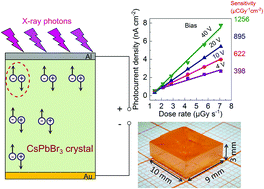High-sensitivity X-ray detectors based on solution-grown caesium lead bromide single crystals†
Abstract
X-ray detection is of great significance for medical diagnostics, industrial non-destructive inspection, nuclear plants and scientific research. However, high sensitivity is needed for X-ray detectors to reduce the radiation dose applied to human bodies for the applications of medical imaging and security checks. Here, we reported sensitive X-ray detectors made of solution-grown inorganic lead perovskite CsPbBr3 single crystals and the synthesis of high-quality inorganic lead perovskite CsPbBr3 single crystals using an improved low temperature solution method, which exhibited high transmittance, mobility and mobility–lifetime products. By designing the detector in an asymmetric electrode configuration, ion migration was effectively suppressed under a high voltage with a low dark current and an outstanding photoresponse. The optimized detector exhibited high sensitivity of 1256 μC Gy−1 cm−2 for 80 kVp X-ray detection under a relatively low electric field of 20 V mm−1, which was 60 times higher than that of commercially used α-Se detectors. Due to its facile synthesis, low cost, long-term stability, and high detection sensitivity, CsPbBr3 is expected to be an outstanding candidate for commercialized sensitive X-ray detectors.



 Please wait while we load your content...
Please wait while we load your content...